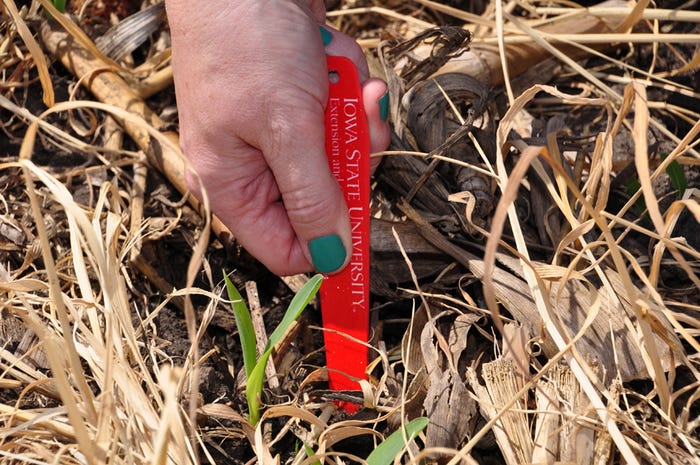June 3, 2017

Start looking for insects before you expect to see them in your fields. That’s the advice Dr. Erin Hodgson, ISU Extension Entomologist, gave to a group of crop scouts in mid-May at a scouting workshop hosted by Iowa State University.
“It’s really important to spend time looking for insects through the growing season,” Hodgson says. “Look for their presence about planting time, and then check again after plant emergence,” she says. “Get some zeros in early scouting so you’ll have a reference for when they first arrived. You should scout every 7 to 10 days for early season insects—you’ll see a few, then a few more. You want to avoid an outbreak.”
Hodgson recommends sampling an entire field, using a defined walking pattern that gives a representative, unbiased sample. She warns against sampling only on field perimeters. “You’ll overestimate if you only scout field edges,” she says, “because almost always, you find more insects on the perimeter of a field.”
A hand lens is handy if your eyes aren’t good enough to see the small legs and heads of insects, Hodgson says, and adds that a lot of the time you’ll see the evidence of insect feeding rather than the insects. Hodgson’s specialty is soybean aphids—she sees signs of feeding injury, not the aphids. “Piercing and sucking insects like aphids, stink bugs and leafhoppers cause discoloration, mottling, punctures and stunting,” she says. “Chewing insects like beetles, grasshoppers, and caterpillars will remove plant tissue, girdle stems, and defoliate and clip plants, so that’s a way to begin to understand what insects are damaging your crop.”
In addition to looking for damaged crops, Hodgson says you should take a sweep net and Ziploc bags to the field so you can capture insects and bring them home for further study. She says to expect to see wireworms feeding on seeds and seedlings below ground. “They live as larvae for 5 to 7 years,” she says, “so if you see them one year, you’re likely to see them again for several more years. We find them a lot in fields transitioning from grass to corn, and an insecticidal seed treatment can help. The story is similar for grubs.”
If you see missing plants, you can use a seed depth finder to dig into the skips to see if larvae are present, she says. “If you do spray, use sufficient pressure and volume with uniform coverage to strive for a 100% kill,” Hodgson says, “and then continue to scout for pests for the rest of the season.”
Hodgson says there are useful materials online, including the risk checklist from Michigan State University shown below. She suggests Iowa producers subscribe to ISU’s Integrated Crop Management News (ICM News) to get notices of current insect activity and other helpful information on crop management. ICM News is online at http://crops.extension.iastate.edu/cropnews.
To find out some tips and tools behind field scouting, check out Part I of the series here.
About the Author(s)
You May Also Like




